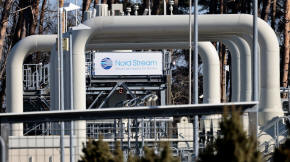Russian gas flows to Europe below demand, threaten storage buildup
 Send a link to a friend
Send a link to a friend
 [June 17, 2022] By
Nina Chestney [June 17, 2022] By
Nina Chestney
LONDON (Reuters) -Russian gas flows to
Europe fell short of demand again on Friday, coinciding with an early
heat wave gripping its south and boosting benchmark prices on concerns
the continent may struggle to build up storage ahead of the winter
season as planned.
Italy and Slovakia reported receiving less than half of the usual
volumes through the Nordstream 1 pipeline, which crosses the Baltic Sea
from Russia to Germany and accounts for around 40% of Russian pipeline
flows to the European Union.
France reported it was receiving no Russian gas from Germany since June
15.
Germany's power industry group said on Friday lower volumes could now be
replaced by other sources, such as Norway and the Netherlands, but the
decline was "worrying" due to the potential impact it could have on
supplies during the winter months.

EU's reliance on Russian gas and a risk that Moscow could cut it off in
retaliation to economic sanctions imposed after its invasion of Ukraine
has been a major headache for the bloc, prompting it to build up
inventories and seek alternative supplies.
An unseasonably early heat wave across parts of Spain and France added
to the concerns, prompting more gas buying as demand for electricity
needed to power air conditioning spiked.
Wholesale Dutch gas prices, the European benchmark, rose as much as 9%
in morning trading, while prices of power supply contracts also rose
across Europe. [NG/EU]
Italy's Eni said it would receive only half of the 63 million cubic
metres per day it had requested from Russia's Gazprom on Friday, after
experiencing a shortfall the two previous days. Earlier, Russia's
Gazprom said it had reduced gas supply to Germany via the pipeline by
almost 60%.
Italian Prime Minister Mario Draghi, who visited Ukraine together with
his French and German counterparts on Thursday, accused Moscow of using
its gas supplies for political reasons.
Kremlin, however, said the supply cuts were not premeditated, blaming
the sanctions for a delay in return of equipment sent for maintenance to
Canada.
Canada said it was in talks with Germany to resolve an issue with a
Siemens Energy turbine for the pipeline, which was serviced there.
HEAT WAVE DEMAND
Italy, which last year sourced 40% of its gas imports from Russia, aims
to have the country's gas storage at least 90% full for the winter
season, up from 54% now.
[to top of second column] |

Pipes at the landfall facilities of the 'Nord Stream 1' gas pipeline
are pictured in Lubmin, Germany, March 8, 2022. REUTERS/Hannibal
Hanschke

Across Europe, storage levels have recovered this year thanks to strong
liquefied natural gas imports. Inventories for the EU as a whole are currently
at 52% of capacity, just below the five-year average and above the 43% seen a
year ago, said analysts at ING Research.
"However, a prolonged outage will raise concerns over the ability of the EU to
build enough storage going into the next heating season," they said. They said
in a "worrying" sign, storage levels fell this week for the first time since
April.
In Denmark, the country's energy agency said that while it could continue to
fill stocks, it was happening at a slower pace due to reduced gas deliveries.
With temperatures soaring, Spanish power plants bought more gas to generate
electricity on Wednesday than any other day since records began, transmission
system operator Enagas said.
Gazprom could increase flows via Ukraine to make up for the Nord Stream
shortfall but there has been no sign of it doing it yet. Added to that, flows
via the Yamal-Europe pipeline have been flowing eastwards for several months
rather than the usual westerly direction to Germany.
Nord Stream 1 is also scheduled for annual maintenance between July 11 and July
21 which will halt all flows.
The United States has been a crucial LNG exporter to Europe for months. But a
blast last week at a major LNG export terminal in Texas will keep it idle until
September and it will operate only partially from then until the end of 2022.

The facility, which accounts for about 20% of U.S. LNG exports, has been a major
supplier to European buyers.
(Reporting by Nina Chestney in LONDON, Stine Jacobsen in COPENHAGEN, Nora Buli
in OSLO, Maria Pia Quaglia in MILAN; Isla Binnie in MADRID; Tom Kaeckenhoff in
FRANKFURT, Jan Lopatka in Prague; Editing by Tomasz Janowski)
[© 2022 Thomson Reuters. All rights
reserved.]This material may not be published,
broadcast, rewritten or redistributed.
Thompson Reuters is solely responsible for this content. |